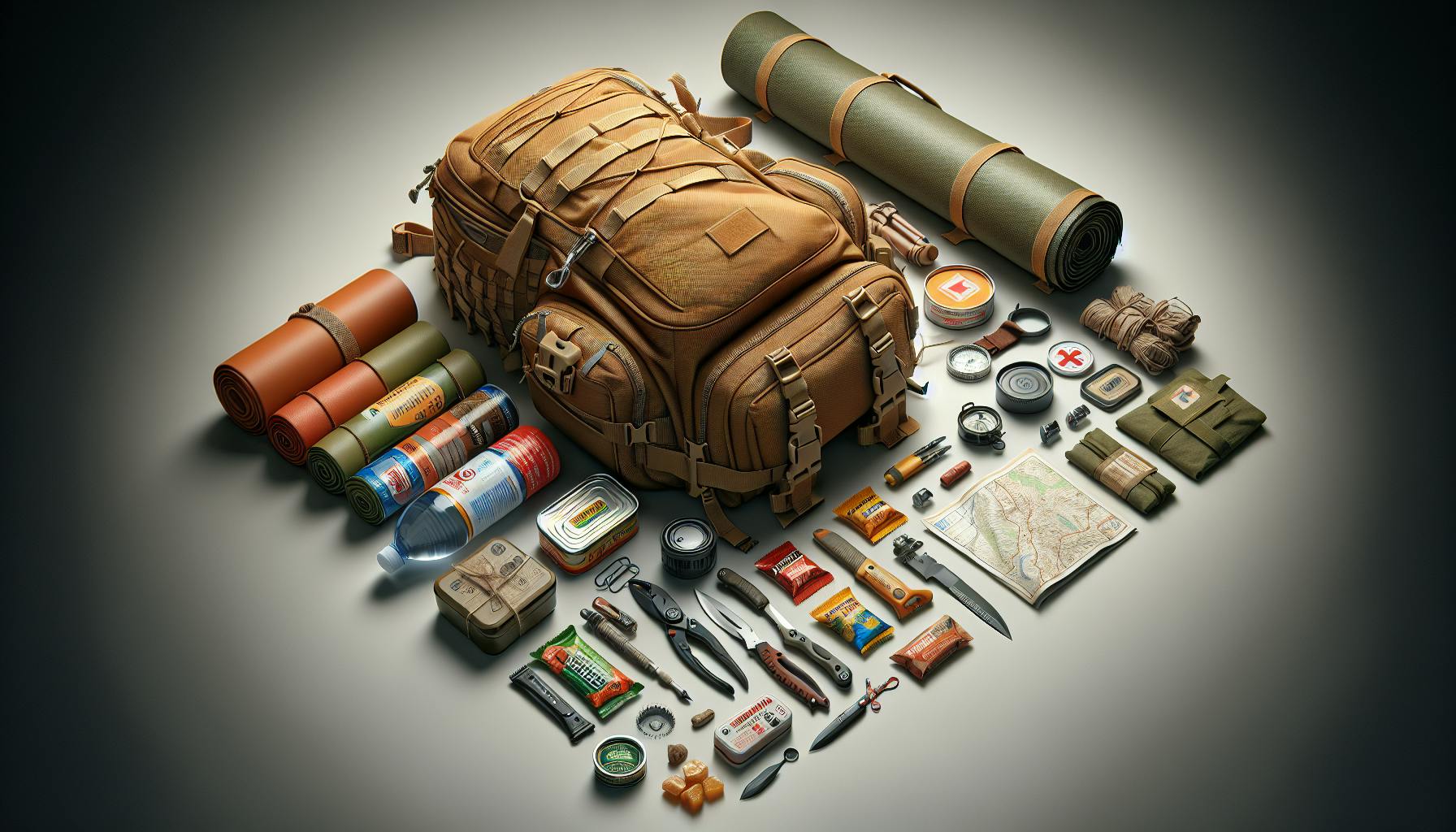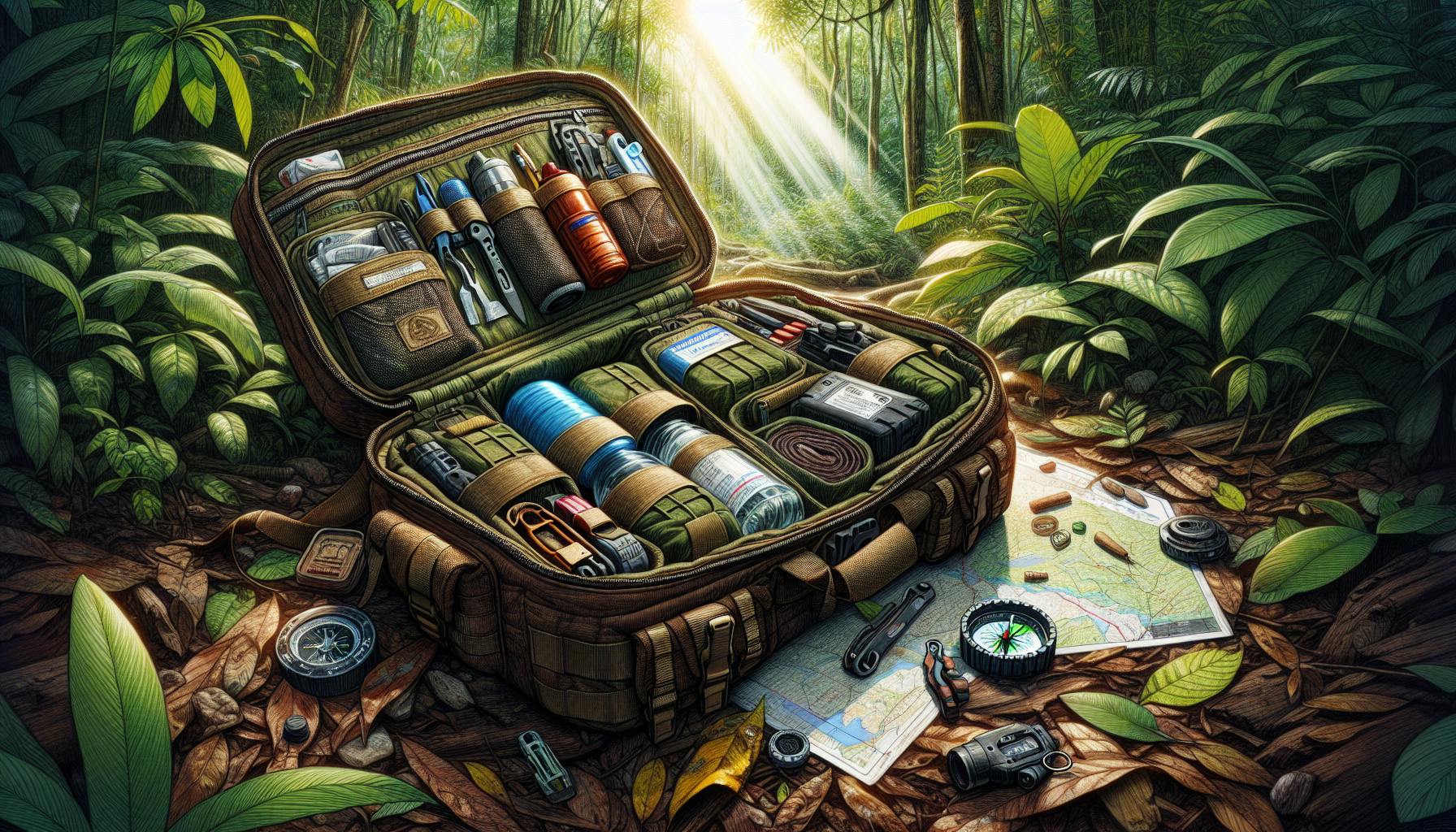When starting out on the prepper's path, assembling an effective bugout bag can seem daunting.
However, by focusing first on the core essentials, new preppers can build a survival kit that serves as a solid foundation for facing emergencies.
In this guide, we'll cover the key components every beginning prepper should include in their bugout bag, along with tips for personalizing and maintaining your mobile provisions over time.
Preparing Your Best Bug Out Bag
Defining the Bugout Bag: A Prepper's First Line of Defense
A bugout bag, also known as a go bag, is a portable survival kit designed for evacuation in an emergency. As a prepper's first line of defense, it contains the critical supplies needed to survive for at least 72 hours when bugging out from a crisis scenario. The key is having your bugout bag prepared ahead of time and ready to grab at a moment's notice. This allows you to quickly evacuate while bringing your most vital gear and provisions. With careful planning, your bugout bag serves as your lifeline if you need to bugoutbag and escape to safety.
The Philosophy Behind the Bugout Bag
Preparing your bugout bag requires strategic thinking to balance readiness and mobility. The supplies must provide for your basic survival needs while remaining compact and lightweight enough for extended travel by foot. Consider your climate, terrain, and possible shelter locations when choosing items. Prioritize mission-critical gear over comforts - the goal is to carry only what you need to survive. With practice and experience, preppers refine their philosophy to pack the most practical and versatile bugout bag. An efficiently packed bag allows increased agility and safety during evacuation.
Essential Qualities of the Best Bug Out Bag
Choosing the best bugout bag backpack involves key considerations around durability, capacity, and wearability. Look for abrasion-resistant fabrics with reinforced stitching to withstand the elements. Storage capacity ranges from 20L to over 60L - choose based on your intended duration in the field. Well-designed shoulder straps and hip belts provide ergonomic comfort for extended treks. Waterproofing and modular components also provide versatility to adapt your system. Invest in a quality bag to trust your survival on when bugging out.
Understanding the Scope of Your Bugout Bag
It's important to understand realistic limitations of your bugout bag's intended use. While extremely useful for evacuations up to 72 hours, sustaining beyond this duration requires additional skills and resources. Always have an emergency action plan for longer-term strategic survival. Cache supplemental gear and establish rally points or safe locations ahead of time. Be prepared to forage, hunt, and scavenge resources from the land. The right mindset and training helps preppers extend their survival radius beyond the bugout bag's supplies. Take inventory and plan your pack's contents diligently for your area.
What is in my bug out bag?
A bug out bag, also known as a go bag or 72-hour kit, contains essential supplies to help you survive for at least 3 days in an emergency situation. As a new prepper building your first bug out bag, focus on gathering basic necessities like food, water, shelter, first aid, tools, and navigation aids.
Food and Water
Having enough food and water is critical in an emergency.Aim to pack at least 1 gallon of water per person per day, and enough calorie-dense food to last 3 days. Good options include:
- Canned goods like beans, vegetables, fruits. Choose pull-tab cans that don't require a can opener.
- High-calorie granola/protein bars
- Freeze-dried camping meals
- Water purification tablets or filter straw
Store food and water in durable, leakproof containers. Replace water every 6 months and food before expiration dates.
Shelter and Warmth
Your bug out bag should enable you to meet basic needs like shelter and warmth if evacuating your home. Useful items include:
- Tube tent or tarp shelter
- Emergency blanket and sleeping bag
- Extra socks, hat, gloves
- Rain poncho
- Fire starting supplies like matches, lighter, tinder
Choose portable, weather-resistant, and insulating gear to protect from the elements.
First Aid Supplies
Pack a well-stocked first aid kit in case of injury, including:
- Bandages, gauze, tape
- Antibiotic ointment
- Medications like pain/fever relievers, anti-diarrhea meds
- Nitrile gloves
- CPR face shield
Rotate medications before expiration and ensure proper storage conditions. Add any personal medications needed for 72 hours as well.
Start with these fundamental supplies tailored for new preppers. Then customize further based on your needs, skills, environment, and possible risks. The key is having versatile gear to address immediate survival needs in an emergency.
What does the term bug out bag mean?
A bug out bag, also known as a go bag, is an emergency kit filled with critical supplies and gear meant to help you survive in the event of a disaster or life-threatening situation. The key purpose of having a bug out bag ready is to allow you to evacuate quickly and sustain yourself until you find safety or help arrives.
The term refers to a bag that contains the essential food, water, clothing, shelter, navigation, medical, and self-defense items one would need to "bug out" or leave a dangerous area in a hurry. The goal is to have a versatile, portable kit packed and ready to go at a moment's notice.
This could mean needing to evacuate due to natural disasters like fires, floods, or hurricanes. Or it could be escaping man-made catastrophes such as infrastructure failures, nuclear events, or societal collapse scenarios. Having an equipped bug out bag gives you the ability to grab your critical gear within seconds and start heading towards safety.
The exact contents of a bug out bag vary based on personal needs and local threats. But most kits focus on having enough supplies to cover your basic survival needs for 72 hours. This includes things like food rations, water filtration, first aid, shelter, fire, light sources, navigation tools, and other mission-critical gear.
Assembling your first bug out bag can be an overwhelming task. But starting with the essentials and building up over time is a good approach. Continually refining and tailoring your bag to your situation will ensure you have what you need if and when disaster strikes.
What food to put in a bug out bag?
When packing food for your bug out bag, focus on non-perishable, calorie-dense options that are easy to prepare and will sustain you in an emergency situation. Here are some of the best foods to include:
High-Calorie Emergency Rations
-
Granola/protein bars: Pack high-calorie granola and protein bars that are non-perishable, lightweight, and easy to eat on the go. Choose options with at least 200-300 calories per bar.
-
Peanut butter: An excellent source of protein and calories. Get single-serve packets so they don't require refrigeration.
-
Nuts and trail mixes: Pack a variety of nuts and dried fruits for essential fats, protein, and an energy boost. Go for calorie-dense options like almonds and cashews.
Easy-to-Prepare Meals
-
Canned meats/fish: Spam, canned tuna, chicken, and salmon are full of protein and require no cooking.
-
Canned fruits/vegetables: Get single-serving pull top cans for quick access. Go for nutritious options like beans, carrots, and mangoes.
-
Oatmeal packets: Individual oatmeal packets just require hot water for a warm, comforting meal.
-
Ramen noodles: Ramen is lightweight, non-perishable, and fills you up. Add peanut butter or canned meat to boost nutrition.
Hydration/Nutrition
- Pack electrolyte tablets, powdered sports drinks, and 2 liters of water in durable water bottles. Include a compact water filter or purification tablets.
Focus on calories and key nutrients first when packing your bug out bag food. Having sustaining rations can be the difference between life and death in an emergency.
Should you keep a bug out bag?
As world events become more uncertain, many people are considering how to prepare for potential emergencies. Keeping a well-stocked bug out bag can provide critical supplies if you need to evacuate quickly.
Why have a bug out bag?
- Gives you essentials if evacuating quickly
- Allows self-reliance if stores/services unavailable
- Peace of mind knowing you have backup supplies
What to include in a starter bug out bag
For beginners, focus on basics like:
- Water - Store at least 1 gallon per person
- Food - High-calorie non-perishables (granola bars, nuts)
- Light - Flashlight, glow sticks, headlamp
- Navigation - Map, compass, GPS device
- Shelter - Tent, tarp, emergency blanket
- Clothing - Weather-appropriate outfits, hats, gloves
- First Aid - Bandages, ointments, medicines
- Tools - Knife, duct tape, fire starter, rope
- Hygiene - Toothbrush, small towel, soap
Tailor your bugoutbag to your needs. Prepare enough supplies for your family or group for at least 72 hours. Replenish food/water every 6 months.
Is a bugout bag necessary?
While major disasters are still rare, being prepared can give peace of mind. Start small with a basic kit, then build up supplies as able. An emergency can happen suddenly, so having a bugout bag ready can be invaluable if you need to leave quickly.
sbb-itb-b932644
The Core Components of a Bugout Bag Survival Kit
A bugout bag, also known as a go bag, is an essential part of any prepper's survival kit. Having quick access to critical supplies can mean the difference between life and death in an emergency situation where you need to evacuate quickly. When building your bugout bag, focus on the core components that will fulfill basic survival needs: shelter, water, food, first aid, tools, and fire.
Shelter and Warmth: Your Portable Refuge
Shelter is one of the most critical elements of survival. Your bugout bag should contain lightweight, portable shelter supplies including:
- Tent or tarp
- Emergency blanket or sleeping bag
- Rope or paracord
- Rain poncho
- Warm layers and socks
Choosing compact, multilayered materials will allow you to adapt your shelter and warmth provisions based on weather conditions and location.
Water Purification and Hydration Solutions
Without clean water, your chances of survival drop rapidly. Pack water purification tablets, a portable water filter like the LifeStraw, and collapsible water containers. Ration your water supply carefully. Additionally, bring electrolyte tablets, juices, or sports drinks to maintain energy and hydration levels.
Nutrition on the Go: Food Essentials
Pack calorie-and-protein-rich non-perishable foods like granola bars, nuts, jerky, and MREs. Calculate how much food you'll need for the duration of your evacuation journey. Consider dietary restrictions too. Rotate and resupply food items to keep them from expiring.
First Aid and Medical Aid Provisions
A comprehensive first aid kit tailored to your skills and needs is vital. Stock essential medications, bandages, ointments, trauma supplies, etc. Customize based on health conditions. Learn wilderness first aid techniques like making splints, treating wounds, providing CPR, and more.
Tools and Fire-Making Gear for Survival
Reliable cutting implements, a compass, duct tape, cordage, and fire-starting supplies are critical survival tools. Choose durable, lightweight options. Fire allows for warmth, light, signaling, sanitation, and cooking. Have multiple methods like matches, lighters, flint, and tinder on hand.
Building your bugout bag to include provisions for fundamental survival needs will prepare you to handle a wide range of emergencies effectively. Invest in quality gear and tailor supplies to your situation. With practice using your equipment and survival techniques, you can assemble a go bag that will help you persevere through disasters.
Advanced Bugout Bag Supplies: Beyond the Basics
For seasoned preppers, a basic bugout bag with essentials like food, water, first aid, etc. is just the starting point. To truly prepare for extended time off-grid and harsh conditions, more advanced gear and planning is required.
Land Navigation Equipment for Precise Location Tracking
Having detailed maps and a durable compass helps track movements and pinpoint locations when GPS fails or runs out of power. Consider a lensatic compass over basic orienteering types for increased durability. Topographic, road, and aerial maps provide context for navigation.
Communication and Signaling Devices
Two-way radios enable communication with group members when cell networks are unavailable. A signal mirror, whistle, and high lumen flashlight provide visual and audio signaling to rescuers when needed. Waterproof storage helps prevent damage.
Self-Defense and Personal Security Items
In unstable environments, self-defense preparedness is a key consideration. Having reliable pepper spray, a tactical baton, or a legal firearm boosts security. Obtain proper training and certifications for any defense items carried.
Clothing and Personal Protection Gear
Insulated, waterproof jackets and pants provide shelter from the elements while on the move. Knee and elbow pads prevent injury when crawling or taking cover. Goggles and protective masks shield from dust, smoke, tear gas, etc.
Escape and Evade: Tactical Considerations
Blending into surroundings helps avoid confrontation. Choose muted color clothing without reflective logos or markings. Camouflage face netting, matte equipment finishes, and surveillance detection techniques aid evasion attempts when confronted or pursued.
Personalizing Your Bugout Bag: Tailored Preparations
As you prepare your bugout bag, it's important to consider your specific needs and situation. Customizing your bag can help ensure you have the right gear and supplies when an emergency strikes.
Assessing Regional Risks and Adapting Gear Accordingly
The risks you may face depend heavily on where you live. Those in hurricane-prone areas will want to prepare differently than those at risk for earthquakes or winter storms. Research likely emergency scenarios for your region and pack gear accordingly. For example, snowy areas may require extra insulation and cold weather clothing.
Incorporating Personal Medical Needs and Preferences
Make sure to pack at least a week's supply of any prescription medications or medical devices you need, along with basic first aid supplies. If you have allergies or dietary restrictions, pack suitable food and snacks. Customize your bag to fit your health, nutrition, and medical needs.
Group Bugout Considerations: Planning for Family and Partners
If evacuating with kids, pets, or others, scale up your supplies. Pack items like diapers, games, leashes, and pet food. Consider each group member's needs and limitations. Having a strategy to stick together is also key. Assign buddies and meetup points.
Training and Skill Development for Effective Bugout Bag Use
Your gear can only take you so far. Educate yourself on survival basics like finding shelter, building fires, administering first aid, and more. Hands-on practice with your gear is also critical. Take your bag on hiking trips to test your packing skills and stamina. Expanding your skillset is vital.
Maintaining and Upgrading Your Bugout Bag
Routine Inspection and Maintenance of Bugout Bag Contents
It is important to routinely inspect and maintain the contents of your bugout bag to ensure items are functional and up-to-date. Experts recommend checking your bugout bag at least every 3 months. When inspecting your bag, check expiration dates on food, water, and medical supplies. Inspect equipment for signs of wear or damage. Replace batteries in flashlights, radios, and other devices. Update maps, contact lists, cash, and important documents. Consider seasonal factors and rotate clothing or shelter items as needed. Performing regular maintenance helps guarantee your bugout bag is ready to deploy at a moment's notice.
Strategies for Expanding Your Survival Kit
As your knowledge grows, consider expanding your bugout bag's capabilities. Initially focus on reliable basics like shelter, water, first aid, navigation and versatile tools. Later you can add supplies for more specialized scenarios like alternative water filtration, radio communication, hunting/foraging, and emergency repair items. Take inventory of your skills and environment to determine what makes sense for your situation. Attend prepper meetups or classes to further develop your capabilities. Upgrade items in your bag with premium versions as your budget allows. An expanded bugout bag enables greater resilience in prolonged emergencies.
Learning from Real-World Bugout Scenarios
Analyzing examples of actual emergency evacuations provides valuable context for using your bugout bag. In many cases, people had little warning before needing to rely on their bags for survival. Study common bugout triggers like natural disasters, civil unrest, infrastructure failure, etc. Examine what items were most/least utilized in different scenarios. Understanding real-world use cases for bugout bags allows you to prepare more effectively. Always have your bag ready to go, as you often won't have time to pack or shop when disaster strikes.
Networking with Other Preppers for Shared Wisdom
Connecting with the broader prepper community allows you to learn from the insights and experience of others. Attend prepper meetings and events in your area to exchange ideas in person. Participate in online forums and groups to get recommendations on gear, training opportunities, useful contacts, etc. Identify a few trusted preppers to collaborate with on planning, resources and skills training. Leverage the specialized knowledge within the prepper network to improve your chances in uncertain times. But verify information and test gear yourself before staking your survival on it.
Conclusion: The Prepper's Journey with a Bugout Bag
A bugout bag is an essential part of any prepper's supplies. As this article has shown, filling your bugout bag with the right gear and supplies can mean the difference between survival and disaster in an emergency situation.
Here are some key points to remember:
-
Pack the basics - water, food, first aid, fire starters, shelter, navigation tools. Prioritize these over comfort items.
-
Choose durable, lightweight, multi-purpose gear. Look for versatile items that serve more than one function.
-
Customize your bag for your needs and climate. Consider factors like weather, terrain, possible evacuation scenarios.
-
Practice using your bugout bag. Test and replace items, adjust your packing system, and identify any gaps.
-
View your bag as one part of your overall emergency preparedness. Develop survival skills, make evacuation plans, and store additional supplies.
Preparing your bugout bag is just the beginning. As you progress on your journey as a prepper, continue learning new skills, gathering knowledge and resources, connecting with like-minded communities, and finding ways to improve your readiness. With vigilance and dedication, you can achieve your goal of self-reliance.


